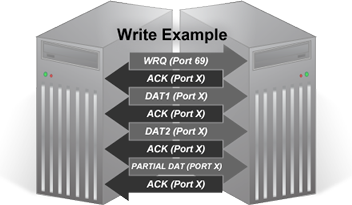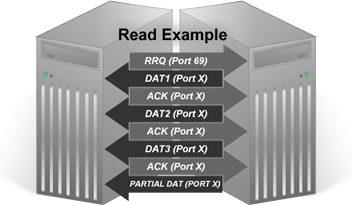Trivial File Transfer Protocol
From Computing and Software Wiki
(→External Links) |
(→References) |
||
| Line 58: | Line 58: | ||
== References == | == References == | ||
| + | <references/> | ||
--[[User:Russeld|Russeld]] 14:48, 5 April 2009 (EDT) | --[[User:Russeld|Russeld]] 14:48, 5 April 2009 (EDT) | ||
Revision as of 20:30, 5 April 2009
Contents |
Overview
The Trivial File Transfer Protocol (TFTP) was developed in 1980 by Noel Chiappa as a simple protocol to transfer files between computers. It is implemented using UDP (Port 69), and is designed to be lightweight (specifically on memory usage) and easy to implement. As such, it is very limited in features compared to other alternatives (FTP, SFTP) as well as security. Due to its lack of security features, it is not safe to use over the open internet, but is still used in private networks as a quick way to transfer files. It is also used to transfer small amounts of data in IP phone firmware as well as in network installations of many current operating systems to load the basic kernel. Windows, Linux and Mac OS all ship with the TFTP server included and disabled by default. The early versions of TFTP were flawed with what was called the Sorcerer's Apprentice Syndrome - causing ever growing packet replication during the transfer.
TFTP has only two features, reading and writing files. It offers no method of listing directory contents, displaying or changing file permissions or even user authentication.
Transfer Modes
TFTP features 3 different transfer modes: netascii, for the transfer of ascii files using 8-bit ascii characters, octet, which transfers binary files byte by byte between computers and mail, which was much like netascii but sent the file to a user rather than to the filesystem. For many years, the protocol allowed transfer of up to 32MB files. This limited transfer size was suitable for its time, however, as most files were small. It wasn't until 1998 in RFC 2348 when option extensions allowed for files up to 4GB which made the protocol more suitable for modern use.
Each transfer through TFTP occurs with a single packet being moved across the network at a time. These packets can either be a block of data or an acknowledgment. As TFTP is implemented using UDP, it utilizes its own methods for transport and session acknowledgement to create a more reliable connection.
Operation
This section will outline the steps that occur during the normal operation of the TFTP server.
Write
- To initialize a write operation, a write request (WRQ) is sent from the local host to the remote server on UDP Port 69.
- If the server is listening and accepting TFTP requests, it sends back an acknowledgment (ACK) to the local host on a randomly assigned ephemeral port. This is the port where the transfer of the actual data will occur.
- Once received by the local host, the first of the data is sent in a 512 byte block to the remote server on the port which the acknolwedgement was received.
- Each data block received by the server is acknolwedged with an ACK message back to the host before the next byte is transmitted. If no ACK is received within the retransmit timer, the unacknowledged block is resent.
- The process continues until a partial data block or an empty data block (when the data fits into a distinct number of blocks) is received, indicating the end of the transfer.
Read
- To initialize a read operation, a read request (RRQ) is sent from the local host to the remote server on UDP Port 69.
- If the server is listening and accepting TFTP requests, it sends back the first block of data to the local host on a randomly assigned ephemeral port.
- Once received by the local host, the host sends back an acknowledgment (ACK) to the remote server on the port which the data was received.
- Each data block received by the host is acknolwedged with an ACK message back to the server before the next byte is transmitted. If no ACK is received within the retransmit timer, the unacknowledged block is resent.
- The process continues until a partial data block or an empty data block (when the data fits into a distinct number of blocks) is received, indicating the end of the transfer.
See Also
External Links
IEN 133
References
<references/>
--Russeld 14:48, 5 April 2009 (EDT)



